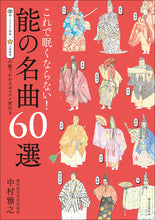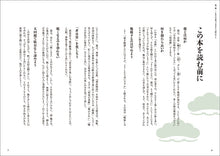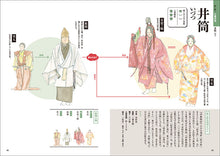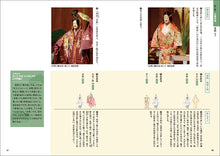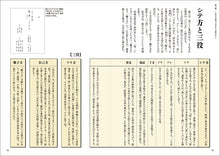
Author: Masayuki Nakamura
*This book was first published in October 2017, and the specifications have been updated for the reprint (second edition).
You can see it through illustrations and photos! You can understand it chronologically as if you were actually watching the play!
A guide to Noh theater for beginners with recommendations
Noh is a Japanese version of musical theatre, consisting of three elements: music (hayashi), song (utai), and movement (mai). Many people have long avoided Noh, saying that it makes them sleepy or is difficult, but that's a shame!
Many people say they want to "study" in order to watch Noh, but the author says that this phrase symbolizes the Japanese people's feelings about Noh. Noh is not something to "study" but to "enjoy." However, the reality is that many people don't know how to enjoy it.
The author, former director of the Yokohama Noh Theatre and an expert on Japan's traditional performing arts, culture, and arts, provides a guide to Noh that even beginners can enjoy, using unique indicators such as the "non-drowsy index" and "performance frequency" to evaluate the performances, as well as bold photographs and illustrations.
There is also a detailed explanation of the costumes, instruments, masks, and other elements that support Noh. You can also learn about the culture and history behind the songs.
By the way, it is natural to become sleepy when you surrender yourself to the soothing music of Noh. The author also says, "If you feel sleepy, it's okay to sleep."
■ Contents Chapter 1: What you need to know about Noh The history of Noh / "Okina" and "Gobankatsu" / "Mugen Noh" and "Genzai Noh" / Shite and Sanyaku / Schools and families / Structure of the Noh stage
Chapter 2: Thirty famous songs that anyone can enjoy: Okina / Lady Aoi / Ataka / Adachi Plain / Izutsu / Iris / Iron wheel / Kinuta / Kiyotsune / Kurama Tengu / Kokaji / Ishibashi / Shojo / Sumida River / Takasago / Tamura / Tsuchigumo / Dojoji / Tomoe / Hagoromo / Half-sleeping / Hachigi / Funa Benkei / Matsukaze / Miidera / Maple viewing / Yashima / Yamauba / Kumano / Yang Guifei
Chapter 3: Noh is a moving museum: Noh masks, costumes, fans, musical instruments, and props
Chapter 4: Thirty-song Aya-tsuzumi for when you want to have more fun / Arashiyama / Ikaku-sennin / Ukai / Quiver / Kagekiyo / Kasuga Dragon God / Tori-Komachi / Handan / Kikujido / Kumasaka / Kocho / Shizen-koji / Shunkan / Xiwangmu / Satsusei-seki / Sotoba-Komachi / Chikubushima / Zhang Liang / Tsunemasa / Tsurukame / Ten-tsuzumi / Nomori / Hanjo / Hyakuman / Fujito / Futari Shizuka / Makikinu / Night Attack on the Soga / Yorimasa
Chapter 5: For those who want to see Noh: Noh performances are a "once in a lifetime" experience; where to watch; find performance information and buy tickets; modern Noh performers directory; Noh stage and Noh theater guide...
*This book was first published in October 2017, and the specifications have been updated for the reprint (second edition).
You can see it through illustrations and photos! You can understand it chronologically as if you were actually watching the play!
A guide to Noh theater for beginners with recommendations
Noh is a Japanese version of musical theatre, consisting of three elements: music (hayashi), song (utai), and movement (mai). Many people have long avoided Noh, saying that it makes them sleepy or is difficult, but that's a shame!
Many people say they want to "study" in order to watch Noh, but the author says that this phrase symbolizes the Japanese people's feelings about Noh. Noh is not something to "study" but to "enjoy." However, the reality is that many people don't know how to enjoy it.
The author, former director of the Yokohama Noh Theatre and an expert on Japan's traditional performing arts, culture, and arts, provides a guide to Noh that even beginners can enjoy, using unique indicators such as the "non-drowsy index" and "performance frequency" to evaluate the performances, as well as bold photographs and illustrations.
There is also a detailed explanation of the costumes, instruments, masks, and other elements that support Noh. You can also learn about the culture and history behind the songs.
By the way, it is natural to become sleepy when you surrender yourself to the soothing music of Noh. The author also says, "If you feel sleepy, it's okay to sleep."
■ Contents Chapter 1: What you need to know about Noh The history of Noh / "Okina" and "Gobankatsu" / "Mugen Noh" and "Genzai Noh" / Shite and Sanyaku / Schools and families / Structure of the Noh stage
Chapter 2: Thirty famous songs that anyone can enjoy: Okina / Lady Aoi / Ataka / Adachi Plain / Izutsu / Iris / Iron wheel / Kinuta / Kiyotsune / Kurama Tengu / Kokaji / Ishibashi / Shojo / Sumida River / Takasago / Tamura / Tsuchigumo / Dojoji / Tomoe / Hagoromo / Half-sleeping / Hachigi / Funa Benkei / Matsukaze / Miidera / Maple viewing / Yashima / Yamauba / Kumano / Yang Guifei
Chapter 3: Noh is a moving museum: Noh masks, costumes, fans, musical instruments, and props
Chapter 4: Thirty-song Aya-tsuzumi for when you want to have more fun / Arashiyama / Ikaku-sennin / Ukai / Quiver / Kagekiyo / Kasuga Dragon God / Tori-Komachi / Handan / Kikujido / Kumasaka / Kocho / Shizen-koji / Shunkan / Xiwangmu / Satsusei-seki / Sotoba-Komachi / Chikubushima / Zhang Liang / Tsunemasa / Tsurukame / Ten-tsuzumi / Nomori / Hanjo / Hyakuman / Fujito / Futari Shizuka / Makikinu / Night Attack on the Soga / Yorimasa
Chapter 5: For those who want to see Noh: Noh performances are a "once in a lifetime" experience; where to watch; find performance information and buy tickets; modern Noh performers directory; Noh stage and Noh theater guide...
Released 02/07
▼Click here for details about the book▼
No more falling asleep! 60 famous Noh plays, 2nd edition | Seibundo Shinkosha Co., Ltd. (seibundo-shinkosha.net)





